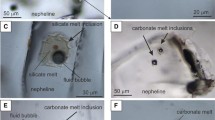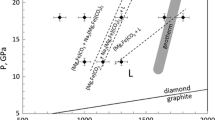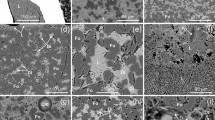Abstract
Minerals of olivine–melilite and olivine–monticellite rocks from the Krestovskiy massif contain primary silicate-salt, carbonate-salt, and salt melt inclusions. Silicate-salt inclusions are present in perovskite I and melilite. Thermometric experiments conducted on these inclusions at 1,230–1,250°C showed silicate–carbonate liquid immiscibility. Globules of composite carbonate-salt melt rich in alkalies, P, S, and Cl separated in silicate melt. Carbonate salt globules in some inclusions from perovskite II at 1,190–1,200°C separated into immiscible liquid phases of simpler composition. Carbonate-salt and salt inclusions occur in monticellite, melilite, and garnet and homogenize at close temperatures (980–780°C). They contain alkalies, Ca, P, SO3, Cl, and CO2. According to the ratio of these components and predominance of one of them, melt inclusions are divided into 6 types: I—hyperalkaline (CaO/(Na2O+K2O)≤1) carbonate melts; II—moderately alkaline (CaO/(Na2O+K2O)>1) carbonate melts; III—sulfate-alkaline melts; IV—phosphate-alkaline melts; V—alkali-chloridic melts, and VI—calc-carbonate melts. Joint occurrence of all the above types and their syngenetic character were established. Some inclusions demonstrated carbonate-salt immiscibility phenomena at 840–800°C. A conclusion in made that the origin of carbonate melts during the formation of intrusion rocks is related to silicate–carbonate immiscibility in parental alkali-ultrabasic magma. The separated carbonate melt had a complex alkaline composition. Under unstable conditions the melt began to decompose into simpler immiscible fractions. Different types of carbonate-salt and salt inclusions seem to reflect the composition of these spatially isolated immiscible fractions. Liquid carbonate-salt immiscibility took place in a wide temperature range from 1,200–1,190°C to 800°C. The occurrence of this kind of processes under macroconditions might, most likely, cause the appearance of different types of immiscible carbonate-salt melts and lead to the formation of different types of carbonatites: alkali-phosphatic, alkali-sulfatic, alkali-chloridic, and, most widespread, calcitic ones.






Similar content being viewed by others
References
Andreeva IA, Naumov VB, Kovalenko VI, Kononkova NN (1998) Fluoride-sulfate and chloride-sulfate salt melts of carbonate-bearing Mushugai-Khuduk complex, Southern Mongolia. Petrologiya 6:307–315
Andreeva IA, Naumov VB, Kovalenko VI, Kononkova NN (1999) Composition of magmas and genesis of teralites of carbonate bearing Mushugai-Khuduk complex (Southern Mongolia). Geokhimiya 8:826–841
Brooker RA (1998) The effect of CO2 saturation on immiscibility between silicate and carbonate liquids: an experimental Study. Petrology 39:1905–1915
Brooker RA, Hamilton DL (1990) Three-liquid immiscibility and the origin of carbonatites. Nature 346:459–462
Carrol MR, Rutherford MJ (1985) Sulfide and sulfate saturation in hydrous silicate melts. Geophys Res 90:601–612
Dawson JB, Pinkerton H, Norton GE, Pyle DM (1990) Physico-chemical properties of alkali carbonatite lavas: data from the 1988 eruption of Oldoinyo Lengai, Tanzania. Geology 18:260–263
Dawson JB, Smith JV, Stelle IM (1992) 1966 ash eruption of the carbonatite volcano Oldoinyo Lengai: mineralogy of lapilli and mixing of silicate and carbonate magmas. Mineral Mag 56:1–16
Egorov LS (1985) Alkali-ultrabasic magmatism and its mineralogy. Geologiya Rudnykh Mestorozgdenii 4:24–40
Egorov LS (1991) Iiolite-carbonatite plutonism (in Russian). Leningrad
Entin AR, Zaitsev AI, Nenashev NI et al. (1990) On the sequence of geologic events related to the intrusion of the Tomtor Massif of ultrabasic-alkaline rocks and carbonatites. Russian Geology and Geophysics 31:42–51
Freestone IC, Hamilton DL (1980) The role of liquid immiscibility in the genesis of carbonatites: an experimental study. Contrib Mineral Petrol 73:105–117
Gallo F, Giammetti F, Venturelli G, Vernia L (1984) The kamafugitic rocks of San Venanzo and Cupaello, Central Italy. N Jahrb Mineral Monatsch 5:198–210
Golovin AV, Sharygin VV, Pokhilenko NP, Mal’kovets VG, Kolesov BA, Sobolev NV (2003) Secondary melt inclusions in olivine of unaltered kimberlites from the Ugachnaya-Vostochnaya pipe, Yakutia. Dokl Earth Sci 388:369–372
Kjarsgaard BA, Hamilton DL (1988) Liquid immiscibility and the origin of alkali-poor carbonatites. Mineral Mag 52:43–55
Kjarsgaard BA, Hamilton DL (1989) The genesis of carbonatites by immiscibility. In: Bell K (ed) Carbonatites: genesis and evolution. Unwin Hyman, London, pp 388–409
Knorring O von, Dubois CGB (1961) Carbonatitic lava from Fort Portal Area in Western Uganda. Nature 192:1064–1065
Kogarko LN (1978) Principle of polarity of chemical bond and its petrologic significance. Problems of petrology of the Earth’s crust and upper mantle (in Russian). Moscow, pp 222–228
Kogarko LN, Plant DA, Henderson CMB, Kjarsgaard BA (1991) Na-rich carbonate inclusions in perovskite and calzirtite from the Guli intrusive Ca-carbonatite, Polar Siberia. Contrib Mineral Petrol 109:124–129
Le Bas MJ (1977) Carbonatite-nephelinite volcanism. Wiley, New York
Legezina OG (1999) Rocks of the Krestovskaya intrusion (north of the Siberian Platform). Geology and mineral resources of the Krasnoyarsk Territory (in Russian). Krasnoyarsk, pp 189–190
Lieber Werner (1997) Bastnasit from Mountain Pass, California. Aufschluss 48:137–142
Luhr JF (1990) Experimental phase relations of water- and sulfur-saturated arc magmas and the 1982 eruptions of E1 Chichon Volcano. Petrology 31:1071–1114
Mikhailov MY and Shatskii VS (1975) A silicon carbide heating element for a high-temperature microscopic stade. Mineralogy of endogenic rocks (in Russian). Novosibirsk, pp 109–110
Minarik W (1998) Complications to carbonate melt mobility due to the presence of an immiscible silicate melt. Petrology 36:1965–1973
Mitchell R (1997) Carbonate-carbonate immiscibility, neighborite and potassium iron sulphide in Oldoinyo Lengai natrocarbonatite. Mineral Mag 61:779–789
Morimoto N (1988) Nomenclature of pyroxenes. Mineral Petrol 39:55–76
Morogan V, Lindblom S (1995) Volatiles associated with the alkaline-carbonatite magmatism at Alno: a study of fluid and solid inclusions in minerals from the Langazsholmen ring complex. Contrib Mineral Petrol 122:262–274
Nielsen TFD, Solovova IP, Veksler IV (1997) Parental melts of melilitolite and origin of alkaline carbonatite: evidence from crystallized melt inclusions, Gardiner complex. Contrib Mineral Petrol 126:331–344
Panina LI, Usol’tseva LM (2000) Role of liquid immiscibility in the formation of calcitic carbonatites of the Malyi Murun Massif (Aldan). Russian Geology and Geophysics 41:655–670
Panina LI, Sazonov AM, Usol’tseva LM (2001) Melilitic and monticellite-bearing rocks of the Krestovskaya intrusion (north of Siberian Platform) and their genesis. Russian Geology and Geophysics 42:1313–1332
Poulson SR, Ohmoto H (1990) An evalution of the solubility of sulfide sulfar in silicate melts from experimental data and natural samples. Chem Geol 85:57–75
Ripp GS, Kobylkina OV, Doroshkevich AG, Sharakshinov AO (2000) Late-Mezozoic carbonatites of Western Transbaikalia (in Russian). Ulan Ude
Ryabchikov ID (1987) Mantle magma formation. Evolution of magmatism in the Earth’s history (in Russian). Moscow, pp 349–371
Samoilov VS, Kovalenko VI, Naumov VB, Sandimirova GA, Chuvashova LA (1988) Immiscibility of silicate and salt melts during formation of Mushugai-Khuduk alkaline complex (Southern Mongolia). Geokhimiya 10:1447–1460
Sazonov AM, Zvyagina EA, Leontiev SI et al. (2001) Platinum-Bearing alkaline-ultrabasic intrusions of the Polar Siberia (in Russian). Tomsk
Shastry A, Kumar S (1995) Petrogenesis of carbonatite veins and associated melanephelinite from Sarnu-Dandali Igneous Complex, Barmer, Rajasthan. Nat Acad Sci Lett 18:139–143
Solovova IP, Girnis AV, Ryabchikov ID (1996) Inclusions of carbonate and silicate melts in minerals of alkaline basaltoids from Eastern Pamir. Petrologiya 4:339–363
Solovova IP, Pyabchikov ID, Kogarko LN, Kononkova NN (1998) Studies of inclusions in minerals of Palabora carbonatite complex (S Africa). Geokhimiya 5:435–447
Suk NI (2001) Experimental study of silicate–carbonate systems. Petrologiya 9:547–558
Suk NI (2003) Experimental studies of fluid-magmatic differentiation of alkaline systems in connection with the problem of genesis of carbonatites.Plumes and problem of deep sources of alkaline magmatism. Irkutsk-Habarovsk, pp 62–74
Veksler IV, Nielsen TF and Sokolov SV (1998) Mineralogy of crystallized melt inclusions from Gardiner and Kovdor ultramafic alkaline complexes: implications for carbonatite genesis. Petrology 39(11–12):2015–2031
Acknowledgements
Our sincere thanks go to J. Touret for commenting on an early version of the manuscript and for his valuable critical remarks. The work was supported by grant 02–05–64617 and grant 05–05–64361 from the Russian Foundation for Basic Research.
Author information
Authors and Affiliations
Corresponding author
Additional information
Communicated by J.L.R. Touret
Rights and permissions
About this article
Cite this article
Panina, L.I. Multiphase carbonate-salt immiscibility in carbonatite melts: data on melt inclusions from the Krestovskiy massif minerals (Polar Siberia). Contrib Mineral Petrol 150, 19–36 (2005). https://doi.org/10.1007/s00410-005-0001-3
Received:
Accepted:
Published:
Issue Date:
DOI: https://doi.org/10.1007/s00410-005-0001-3




